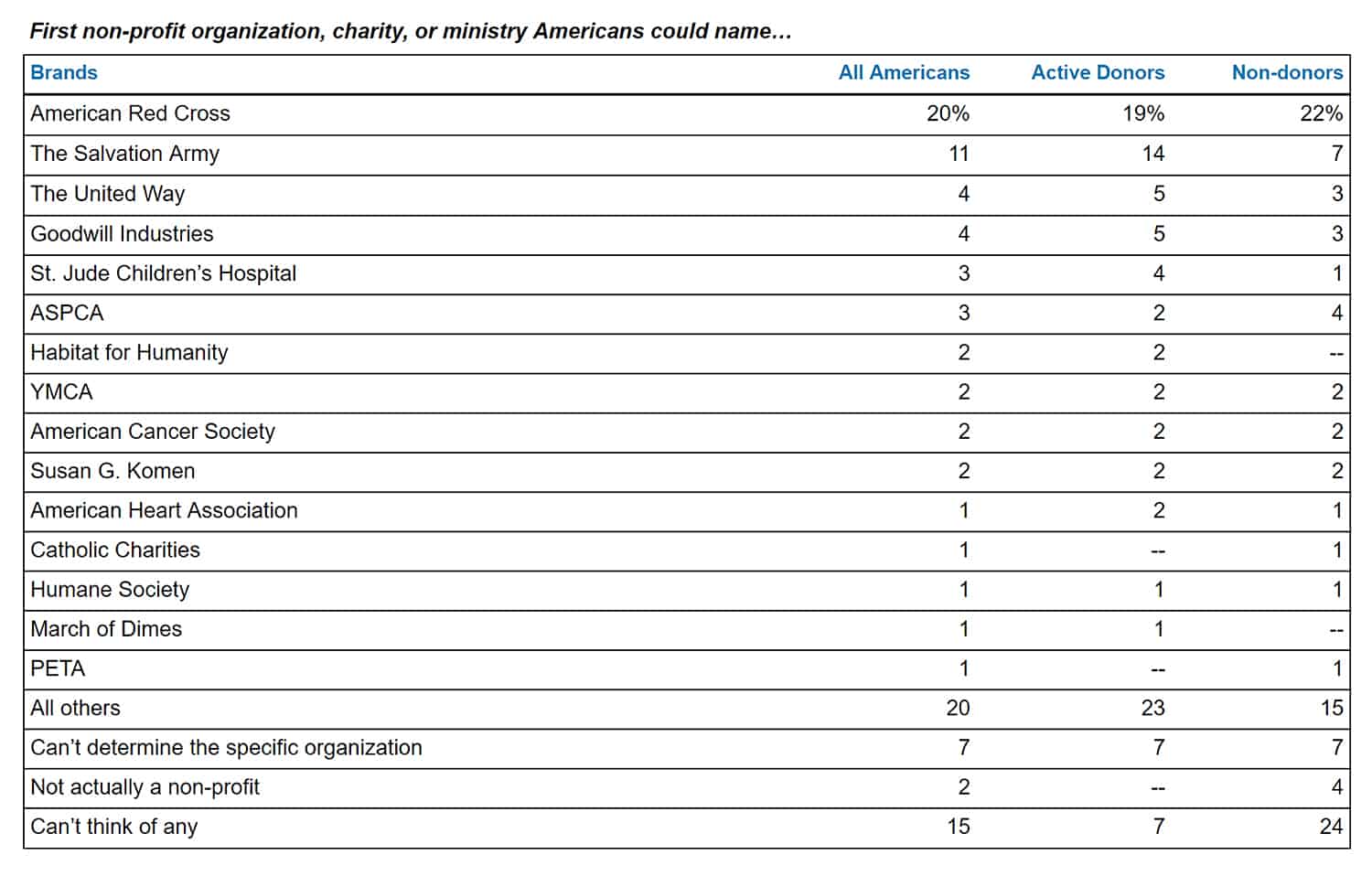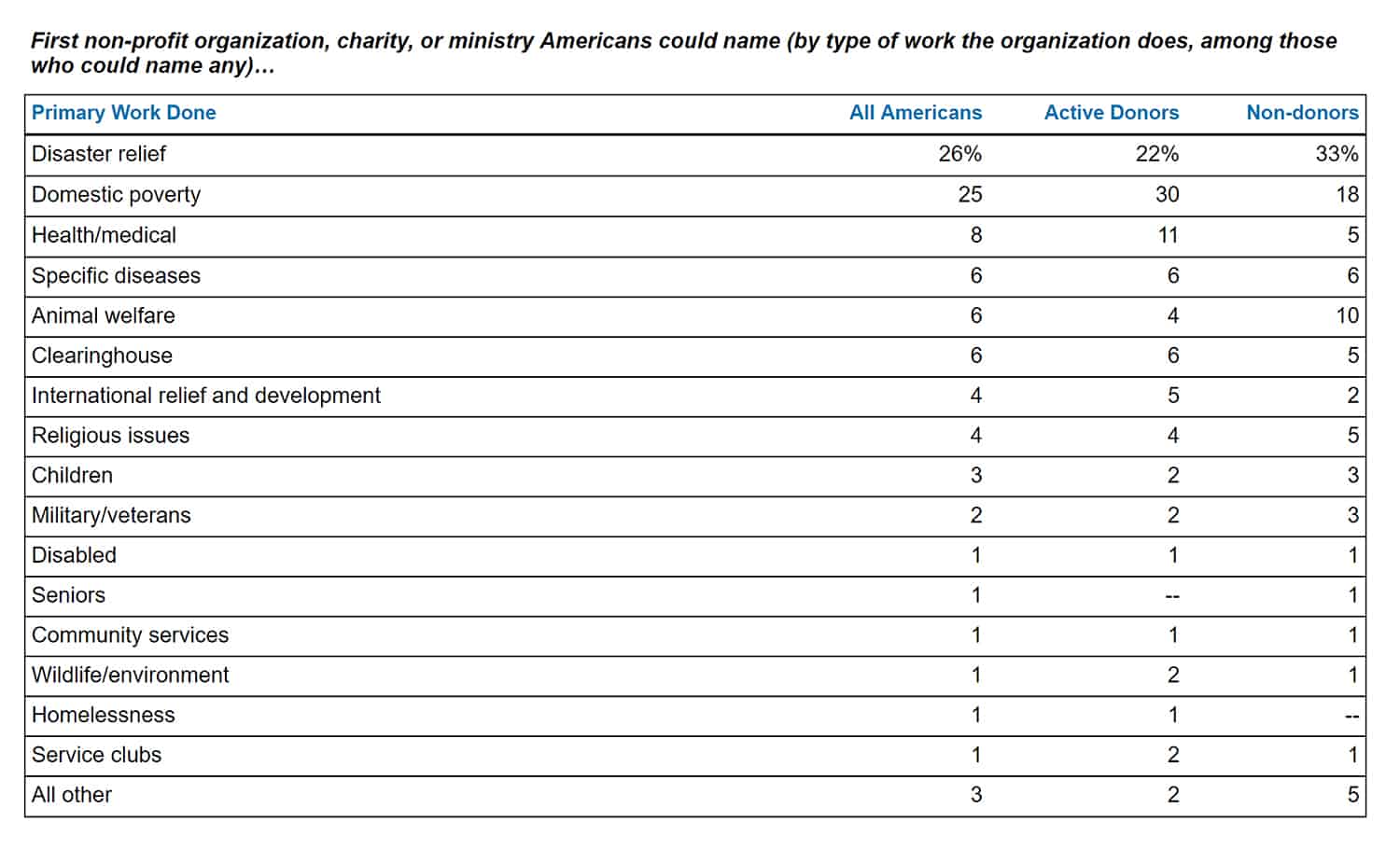Americans think first of non-profit organizations that are massive, international, and non-religious.
A new study just released by Grey Matter Research (Phoenix, AZ) shows that when it comes to brand awareness in the non-profit world, size definitely does matter.
Previous brand awareness studies in the non-profit sector have mostly concentrated on ranking awareness of individual brands. These studies generally show brand awareness of non-profits is highly fragmented, with low levels of unaided awareness for even some of the largest organizations. Because of this, such studies can provide limited insight.
Grey Matter Research asked a demographically representative sample of American adults to name the first non-profit organization, charity, or ministry that comes to mind for them (excluding any local place of worship). But rather than just rank individual brands, Grey Matter categorized the various brands by size, primary type of work, geographic focus, and religious connection.
First, this study confirmed what others before have found: other than a couple of major brands, first-mention brand awareness for any individual non-profit is almost non-existent. The American Red Cross is the first brand that comes to mind for 20% of Americans, followed by The Salvation Army at 11%. No other individual organization is named by even 5% of respondents. Eight brands were named by 2% to 4% of Americans each (United Way, Goodwill, St. Jude Children’s Hospital, Habitat for Humanity, ASPCA, American Cancer Society, YMCA, and Susan G. Komen). Scores of individual organizations were named by just one or two people out of over a thousand in the study.
Together, just these ten organizations account for over half of all first-mention brand awareness for non-profits among American consumers (52%). Considering that 15% of Americans couldn’t think of a single non-profit when asked, and 2% thought of a name that is not actually a non-profit (e.g. the United Nations), this leaves combined first-mention awareness for all the tens of thousands of other non-profits at 24%. (Seven percent provided an answer that did not allow for a specific organization to be identified, such as “that cancer group” or an acronym that is used by more than one organization.)
Digging even deeper, the study shows that what people tend to be most aware of are massive organizations with no religious affiliation that do their work internationally.
Among people who could name a non-profit organization, 68% named one that does international work, while 23% named an organization that focuses on the U.S. Only 9% named an organization that primarily does local or state-level work.
Fifty-one percent named an organization with total revenues of $1 billion or more. Most of the rest (30%) think first of an organization with between $100 million and $999 million in total revenues. Only 19% think first of a smaller organization, including just 2% who think of an organization with under $1 million in total revenues. (Revenue figures are taken from the most recent IRS form 990 available for each organization someone mentioned.)
Three out of four organizations Americans think of first are not religiously connected in any way (76%). Eight percent have a broad or non-sectarian Christian background, while 15% are more specifically connected with a Protestant religious group or perspective. Two percent are Roman Catholic, while 1% come from any other religious background.
Categorizing the work non-profits do is challenging, because some are involved in multiple efforts that are very different (for example, the Red Cross with blood donations, support of military families, and disaster relief). However, for the study a judgment was made about the primary focus of each organization or what it is best known for. Half of the organizations people think of first are involved either in disaster relief (26%) or domestic initiatives related to the poor and needy (25%). Other causes well-represented in first-mention brand awareness are health/medical (8%), specific diseases such as cancer or diabetes (6%), and animal welfare (6%).
What is also noteworthy is how infrequently organizations representing certain causes come to mind for Americans – rarely do people think first of organizations representing the arts or museums, schools or any other type of education, religion, military or veterans, or wildlife/environment.
People who have actually given to a non-profit organization (other than a local place of worship) in the past year and those who have not are not widely different in their brand awareness. Donors are more likely to be able to name a non-profit (93% to 72%), but like non-donors they are most aware of a small number of major brands. Donors are more likely than non-donors to think first of organizations offering help to the poor and needy inside the U.S. and to health/medical causes, while non-donors are more likely to think of organizations working on animal welfare or disaster relief. Donors are also more likely than non-donors to think first of an organization with a Christian background (26% to 17%). But all in all, donors and non-donors are more similar than different in these measures.
Ron Sellers, president of Grey Matter Research, noted that most of the top brands have enjoyed extensive public exposure. “In any major disaster, the media is reporting what the Red Cross is doing. Goodwill has 2,700 stores that people visit or drive by every day. ASPCA and St. Jude have run memorable fundraising campaigns on television. Watch any NFL game and you’ll see multiple United Way commercials. The Salvation Army’s red kettles are everywhere at Christmas. All of these things stick in people’s minds and drive brand awareness,” Sellers said.
Sellers also explained that what donors are most aware of and what they prefer can be two very different things. Grey Matter Research partnered with Russ Reid Company in 2010 for the large-scale Heart of the Donor study, which found that by a two-to-one margin, donors say they prefer supporting smaller organizations where their gift might have more impact over larger organizations with wider reach. “While many people may prefer smaller organizations, it’s generally the big, visible ones that capture their attention,” Sellers said. “Our research has shown that many donors don’t strategically plan their giving; they give as needs arise and as organizations capture their attention. So while they may prefer smaller organizations, if the larger ones are successful at getting their attention, that gives the larger non-profits a decided advantage in turning that visibility into financial support.”
Study Details:
The study was conducted by Grey Matter Research, a research and consumer insights company located in Phoenix, Arizona. Grey Matter has extensive experience in research related to non-profit issues, with numerous non-profit organizations as clients. The sample of 1,011 adults is accurate to within ±3.1 percentage points at the 95 percent confidence level with a 50 percent response distribution.
The study was conducted in all 50 states. Respondents’ age, education, household income, geography, racial/ethnic background, and gender were carefully tracked and weighted to ensure appropriate representation and accuracy.





